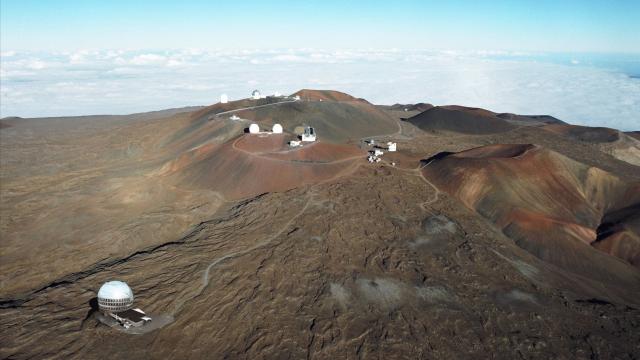Native Hawaiians have a long history of losing battles over their land. This stems all the way back to the late 1800s when white sugar farmers overthrew the Hawaiian Kingdom. Today, the battle lines are drawn around Mauna Kea, a sacred mountain that’s ultimately what drew the Polynesians to Hawaii, according to folklore. Ancestors are buried there, and the mountain itself is considered an ancestor.
Now, a controversial, state-of-the-art telescope is set to break ground along Mauna Kea’s slopes. Last Tuesday, the Hawaiian Supreme Court ruled to approve the construction of the Thirty Meter Telescope (TMT), an observatory that would have the ability to gaze farther into the universe than any current telescope can. Its creation could literally transform our understanding of the world. But that’s only if community members allow it to be built, and opponents don’t plan on backing down easily.
“We’re at the last straw,” Hanalei Fergerstrom, a Native Hawaiian priest and opponent to the project who has testified against the project in court, told Earther. “The last thing we have is our sacred space, and it’s come down to the point where we must take a stand. Period. At whatever cost it’s gonna cost—and we’re prepared to exhaust those costs.”
This battle has been ongoing for a long time. Litigation against the TMT first began in 2013, and in 2015, protestors managed to pause construction for two months when telescope crews attempted to break ground. At the time authorities conducted more than 30 arrests, according to Business Insider.
Opponents scored another win in late 2015 when the TMT’s first construction permit was new permit issued in 2017 places the project back on.
Not many legal options remain to stop the project, but Fergerstrom said opponents won’t hesitate to take nonviolent direct action again. Organisers on the Big Island of Hawaii, where Mauna Kea is, have already heard from Hawaiians on other islands who plan to head to the mountain to help protect it.
“We’re always looking for a way to humbly respond to this, but it is not the state’s intent to make anything better,” Fergerstrom told Earther. “They want their way, and they want us out of their way .”
Many Native Hawaiians have a special relationship with the mountain. Not only are ancestors buried here, but high priests come here to pray. Today the mountain holds a number of ‘ahus, religious altars made of stones. But this isn’t a fight between science and religion. Opponents of the TMT are upset that the summit, considered one of the best places in the world for astronomy, is already home to 13 observatories.
Those opponents see the construction of yet another observatory as a land sovereignty issue. And some astronomers who would benefit from the creation of the telescope sympathize with that argument.
Chanda Prescod-Weinstein, a cosmologist doing postdoctoral research at the University of Washington, suspects this telescope will help her work, but she also recognises the way this court ruling further damages indigenous people’s ability to fight for their sovereignty—as well as the scientific community’s ability to distance itself from its colonial past.
“Science has long actively benefited from colonialism, and the scientific community has often been a willing participant in colonialism—from enhancing the speed of the Atlantic slave trade to building telescopes on sacred lands without getting permission from indigenous people first,” Prescod-Weinstein wrote to Earther in an email. “A legal ruling that affirms that this is ok is, of course, a blow to changing these colonial ways. Decolonization is necessary if we are ever going to do science ethically.”
Astronomer Nicholas Suntzeff, who chairs the astronomy department at Texas A&M University, is sad about the ruling. The Native Hawaiians deserve more than this after all they’ve been through, he said.
“This one thing isn’t going to cause them to lose their culture, but it’s just another thing going on as they get marginalized in [the United States] and in the islands of Hawaii,” he told Earther. “It makes me sad to think of that.”
Still, not all Native Hawaiians hate the idea of this telescope on Mauna Kea. In fact, a 2016 poll found that they’re split pretty evenly on their support for TMT. And for the half who don’t want the telescope, there may be a few silver linings.
The project developers, including the University of Hawaii and California Institute of Technology, plan to conduct cultural training for staff to help alleviate some of the opponents’ concerns. They will also have “cultural and archaeological monitors and experts” onsite during construction in case anything is uncovered. Scott Ishikawa, a spokesperson for the TMT, could not clarify if these experts will come from the community or elsewhere. The TMT will also now contribute $US1 ($1) million annually to the Hawaiʻi Island New Knowledge Fund, which aims to bring more Hawaii island students into the STEM sector.
All of this is a start, but it may not be enough to silence protestors. The TMT team is aware of this, and it’s counting on the state to help ensure workers can safely begin construction, Ishikawa told Earther. The construction date is still pending, as it hinges on the TMT securing a conservation district use permit it needs to build on the mountain.
“We promise we’ll be good stewards of the mountain if we’re allowed to build up there,” Ishikawa said.
That “if” weighs heavy. Plan B is to build the telescope in the Canary Islands. Opponents won’t quit until Plan B becomes Plan A.
Correction: Nicholas Suntzeff’s quote was corrected to clarify that he said this project alone isn’t going to cause Native Hawaiians to lose their culture. Due to a transcribing error, he was previously quoted as saying it would.
